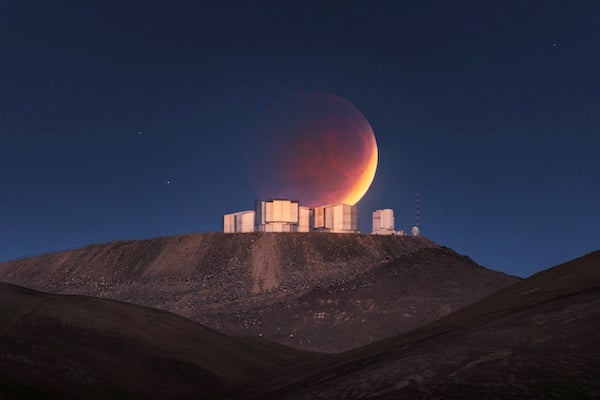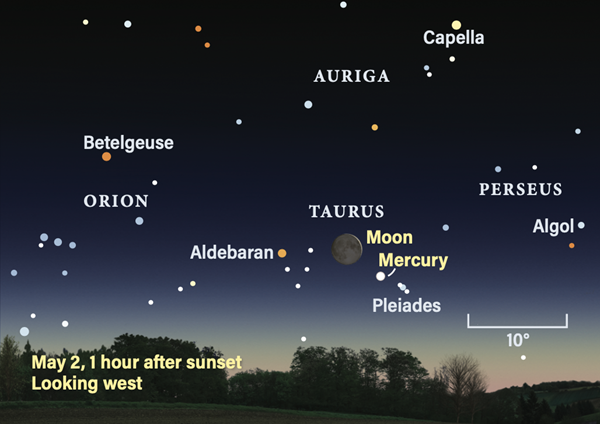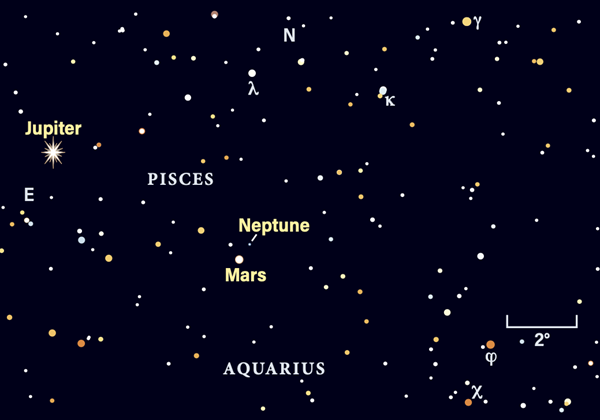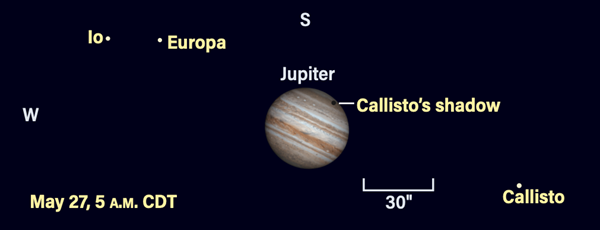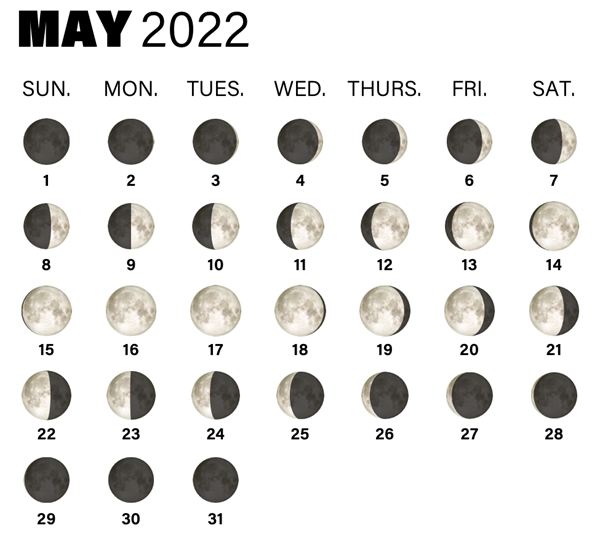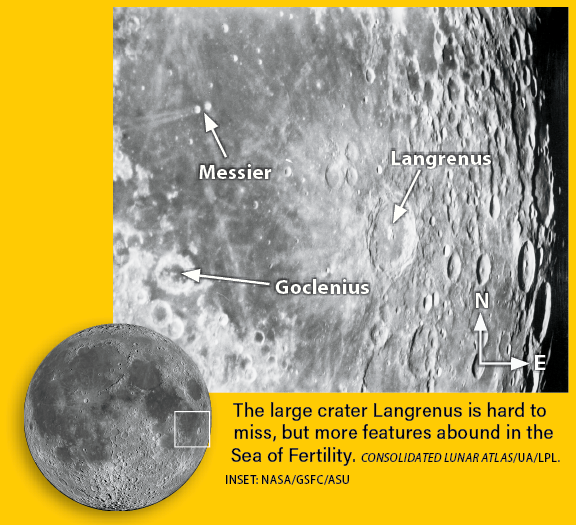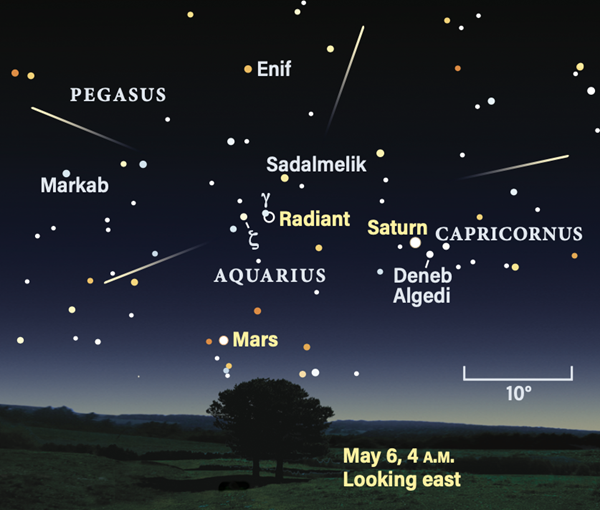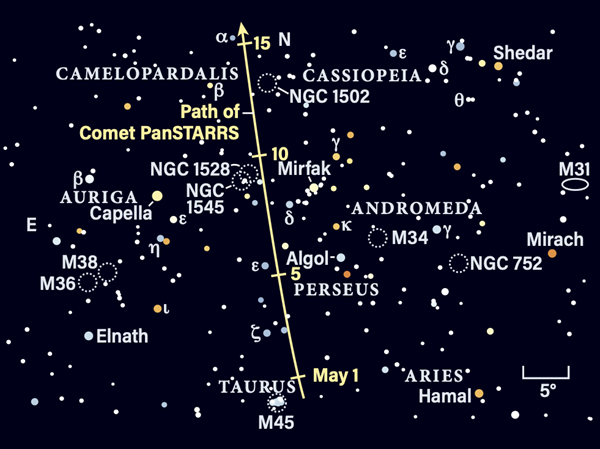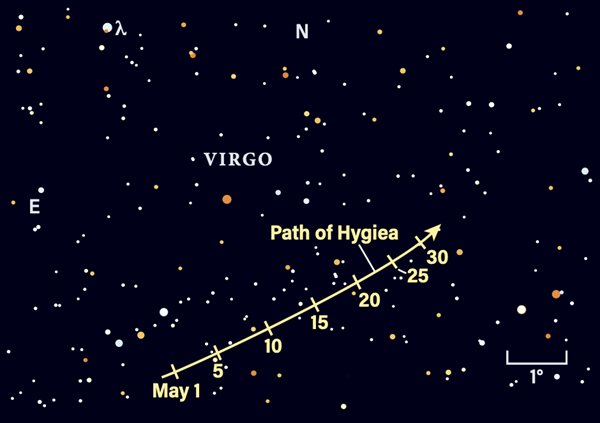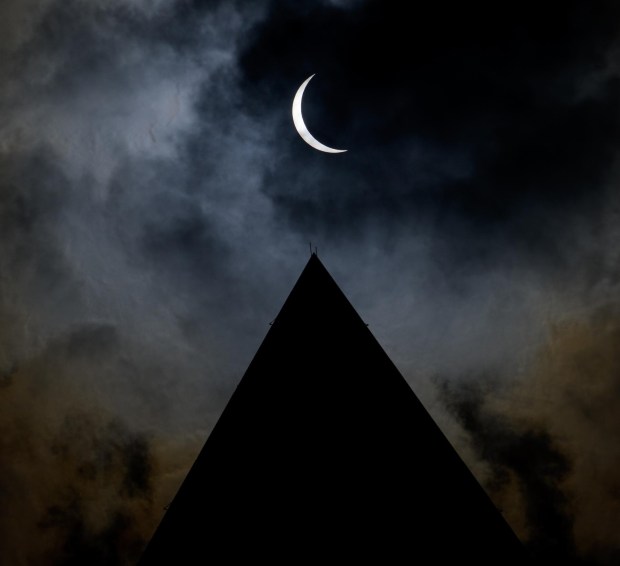A total eclipse of the Moon greets observers of the sky this month. It’s perfectly timed for the evening of May 15 across the U.S. and the early morning hours of May 16 in Europe, Africa, and the Middle East. Meanwhile, catch Mercury early in May, ending its period of best evening viewing this year for Northern Hemisphere skygazers. It quickly sinks out of view. This leaves planetary observers to enjoy the pre-dawn treat of four visible planets, starting out with Venus and Jupiter spectacularly close, while Saturn and Mars continue to climb higher in the morning sky.
Mercury shines at magnitude 0.5 on May 1, hanging 11° high in the western sky 45 minutes after sunset. The Pleiades (M45) linger nearby and become visible as twilight fades. A 1.2-day-old crescent Moon sits 7° below Mercury and M45 — look for its very slender crescent just above the horizon. Once the sky is dark enough, look also for the binocular Comet C/2021 O3 (PANSTARRS) 3.5° to the right (northwest) of the Pleiades. The comet’s path will take it due north into Perseus, and it should be visible over a few nights — but its brightness will certainly surprise observers, either because it is fainter or brighter than predicted, so keep an eye on it.
The crescent Moon slides farther along the ecliptic by May 2, now higher than Mercury (4.5° away). It’s a beautiful sight with the Hyades and 1st-magnitude star Aldebaran, the Moon, Mercury, and M45 spanning the western horizon — one not to be missed.
Watch Mercury each evening for as long as you can. The small planet drops to magnitude 1.4 by May 7, becoming harder to spot. It reaches inferior conjunction with the Sun on May 21, and will reappear by next month in the morning sky.
Late on May 15, observers across the U.S. will be greeted with a total eclipse of the Moon, the first of two this year (the second one occurs early on the morning of Nov. 8). The Full Moon is two days from perigee, spanning nearly 33′ as it crosses the central part of Earth’s shadow, resulting in a longer-than-average 85-minute period of totality. The eclipse occurs with the Moon located in Libra the Balance; the later evening hours reveal the orange glow of Antares in neighboring Scorpius, providing a lovely complement to the orange-hued eclipsed Moon.
The visibility of the eclipse is time zone dependent. East Coast observers will see the whole eclipse in a dark sky. In the Midwest, the Full Moon rises in the eastern sky with the penumbral stages underway, enhancing the effect of the subtly progressing shadow. Observers in the Mountain time zone see the partial eclipse already underway in twilight. From the West Coast, the onset of totality occurs in twilight and the later stages of the eclipse are visible in a dark sky.
The lunar eclipse begins with the penumbral shadow — a subtle shading barely visible on the Moon’s lower limb — at 9:32 P.M. EDT. The Moon reaches the dark edge of the deep umbral shadow at 10:27 P.M. EDT. Dusky gray first creeps across the lunar surface and, as more of the Moon sinks into the shadow, an orange coloring will become noticeable, particularly through a telescope.
Totality lasts from 11:29 P.M. to 12:53 A.M., spanning 85 minutes (all times are EDT unless otherwise noted). Mid-totality occurs at 12:11 A.M. For observers along the eastern coast of the U.S., the Moon then stands at least 25° high in the southern sky. Our satellite appears at progressively lower altitudes for observers farther west. Enjoy the spectacular view of the deep orange Full Moon floating in a star-studded dome. Enhanced views from the country will reveal the summer Milky Way rising in the southeastern sky, normally blocked out by the light of the uneclipsed Full Moon. The partial phases progress until 1:55 A.M. and the final penumbral trace leaves the disk imperceptibly by 2:50 A.M.
The ringed planet Saturn rises around 3 A.M. local time on May 1, located in eastern Capricornus the Sea Goat. By the end of May, it’s up around 1 A.M. It starts the month at magnitude 0.6 and stands 1.7° north of Deneb Algedi, which shines two magnitudes fainter. The planet is best viewed in the hour before dawn, when it stands more than 20° high in the southeast.
Through a telescope, Saturn displays a 17″-wide disk and its fine rings span more than twice that distance. The rings’ tilt is noticeably different than last year, and in May and June they’re at 12° to our line of sight. This is the minimum angle for 2022 — the tilt increases to 15° through opposition later in the year.
On May 6, the main-belt asteroid 4 Vesta stands between Saturn and Deneb Algedi. The 7th-magnitude asteroid is within easy reach of binoculars, only 0.7° south of Saturn. Vesta treks eastward and remains within about 1° of Saturn for three days either side of the 6th.
Mars rises shortly before 4 A.M. local time on May 1, and nearly hour earlier in late May. It brightens from magnitude 0.9 to 0.7 during the month as it treks from eastern Aquarius into Pisces. On May 8, it stands within 0.5° of 4th-magnitude Phi (ϕ) Aquarii. Of greater interest is May 17 and 18, when Mars glides south of Neptune. The actual moment of conjunction takes place during daylight hours on May 17 for U.S. observers, but on the morning of the 18th, you’ll find the 8th-magnitude, bluish glow of Neptune 33″ northwest of the Red Planet.
In the run-up to Mars’ second conjunction of the month, look out on the early morning of May 25 to see the waning crescent Moon in the vicinity of Mars and Jupiter, which stand 2.4° apart. The Moon floats 5.5° east of Jupiter. A few days later, on May 28, Mars slides 0.6° south of Jupiter. Rising together shortly before 3 A.M. on the 29th, the two planets are still the same distance apart by 5 A.M. local time, standing 25° high in the eastern sky. Over in the eastern end of Pisces is Venus, which rises around 4 A.M. local time.
Jupiter shines at magnitude –2.2 and Mars is magnitude 0.7. Their color contrast is stunning. The two planets remain within 1.5° of each other through May 31. Through a telescope, Mars is still tiny, spanning 6″ compared with Jupiter’s 37″.
May opens with Jupiter and Venus still close together following their late April conjunction. The stunning pair of planets rises just after 4 A.M. local time, just 33′ apart. Venus shines at magnitude –4.1 and Jupiter is dimmer but still brilliant at magnitude –2.1. A low-power telescope will show both planets beautifully. Venus boasts a 17″-wide disk that is 68 percent lit, and Jupiter spans 35″ and is flanked by its four Galilean moons, two on each side. Follow them into early twilight — when Venus is less dazzling — for some of the best views.
Over the following days, Venus and Jupiter separate, with Jupiter extending its angular distance from the Sun while Venus reduces its elongation. Jupiter is a fine object with improving visibility as the month progresses. A notable transit of Callisto’s shadow occurs in the early morning of May 27. You can spot the shadow moving across Jupiter’s southern polar region over a period of nearly 2.5 hours, beginning at 5:31 A.M. EDT. Jupiter’s largest moon, Ganymede, casts its own shadow across Jupiter’s cloud tops on May 29, beginning at 3:49 A.M. EDT. The transit is underway as Jupiter rises in the Midwest and in its later stages for West Coast observers.
By May 27, Venus spans 14″ and is 76 percent lit. A waning crescent Moon stands less than 4° away in morning twilight. Earlier in the day, notably for those in southeast China and southeast Asia, the Moon occults Venus, passing in front of it from our point of view.
The morning star’s visibility continues through the end of May, when the planet rises just before 4 A.M. local time and stands about 10° high as twilight begins.
Uranus is in conjunction with the Sun on May 5 and consequently is not visible most of the month. The ice giant begins to reappear, awash in the morning twilight, by the end of May.
Rising Moon: Multiplying in the Sea of Fertility
To the eyes of a newcomer, Tycho’s terrific ray system near Full phase is one of the most impressive features on the Moon. Put on your shades or screw in a filter to reduce the glare, and let’s follow one ray across to the Sea of Fertility (Mare Fecunditatis). Through a scope with a diagonal, this is to the upper left of Tycho, while in a Newtonian this is to the lower left. The ray first passes through the Sea of Nectar and practically pierces the small crater Rosse.
After crossing some highlands, it seems to skip over the perfectly round, lava-filled crater Goclenius, then continues across the rest of the large impact basin that is the Sea of Fertility. Did the higher elevations of the highlands and crater rims produce ray shadows where no ejecta material could fall?
On the opposite shore, numerous short rays spread out from Langrenus like spokes on a bicycle wheel. In the center north, you can’t miss the really cool parallel rays shooting out of the double crater Messier. Next, follow the two long rays crossing from north to south. They converge on their source, the large crater Furnerius, itself straddled by two small streak systems. You have from May 9 to 17 to ride the rays.
The incessant solar wind darkens the lighter streaks over time, but in a future so remote that these have disappeared, humanity may have already moved on from our current home.
Meteor Watch: In favor
The Eta Aquariids are favorable this year due to a near-First Quarter Moon that sets between midnight and 1 A.M. local time, offering dark skies during the early morning hours of the May 6 peak. The shower is active from April 19 through May 28, as Earth sails through debris that Halley’s Comet shed during one of its many orbits.
On mornings away from the peak, rates are very low for Northern Hemisphere observers due to the low altitude of the radiant. The radiant lies near Zeta (ζ) and Gamma (γ) Aquarii, and rises shortly before 3 A.M. local time in the continental U.S. It reaches an altitude of nearly 20° one hour later, just as the first signs of twilight begin. The low altitude attenuates the zenithal hourly rate of 50 meteors per hour down to an expected observable rate of five to 10 per hour. These swift meteors travel at some 40 miles per second.
Comet Search: Second comet of the decade?
Ready to witness a fantastic glowing sword standing straight up from the recently set Sun? Comet C/2021 O3 (PanSTARRS) could be it. Or it could instead dissolve suddenly in a whimper.
The night of May 2 could go down in history: In deepening twilight, Comet PanSTARRS sits photogenically a few degrees right of Mercury (magnitude 0.6), while the Pleiades star cluster (M45) sparkles between them and a thin crescent Moon full of earthshine smiles just off to the left. Plan for travel if you can. We will have three days’ notice that the performance is on. This is a rare opportunity.
Though PanSTARRS is fading after perihelion on April 21, beneficial geometry kicks in during early May. Dust lights up when we see it in the direction of the Sun. The forward scattering angle is at a minimum on the 4th, similar to what we saw with comets C/2006 P1 (McNaught) and C/1975 V1 (West). In the nights following, the main body shifts up and away into Perseus but the dust swings into alignment.
Ignore the waxing Moon to watch PanSTARRS as long as possible. It slowly fades into binocular range while climbing toward Polaris. On May 10, it passes the picturesque starfield of Perseus’ left arm, which contains the star cluster NGC 1528 and its compact neighbor NGC 1545. Give it a try anyway on the moonglow weekend of May 13 to 15, some 3° from Kemble’s Cascade and NGC 1502.
Although PanSTARRS probably won’t trigger the clickbait hype of media newsfeeds, don’t slip into “Oh, I’ll see it tomorrow” mode and miss out.
Locating Asteroids: Look south of Lambda
As twilight fades on mild spring evenings, the blue luminary Spica climbs in the southeastern sky. Following it 40 minutes later and a bit to the south is the main-belt asteroid 10 Hygiea. Far from the confusing swarms of Milky Way stars, it won’t be hard to track. Glowing at magnitude 9.3, Hygiea will need a 4-inch scope from the suburbs to catch your eye. Star-hoppers should start with Lambda (λ) Virginis and make their way south.
In a low-power field of view up to 1° across, only one or two stars challenge Hygiea for brightest object. That’s pretty much how Frenchman Annibale de Gasparis discovered it in April 1849, but on the other side of Spica. Patiently comparing eyepiece views to star charts and picking out the stranger was still the only way to uncover the unknown at that time, nearly 50 years after 1 Ceres first came to light between the orbits of Mars and Jupiter.
It will be a long time before a spacecraft visits Hygiea. Modern studies show it is quite round at about 280 miles across, and its key feature is its low reflectivity of only 7 percent — barely brighter than the Moon’s dark surface and a dark cousin to shiny 4 Vesta’s 40 percent. Because it shares characteristics with stony meteorites, some astronomers have deduced that Hygiea completely shattered in a huge impact long ago and later coalesced into a low-density glob.

